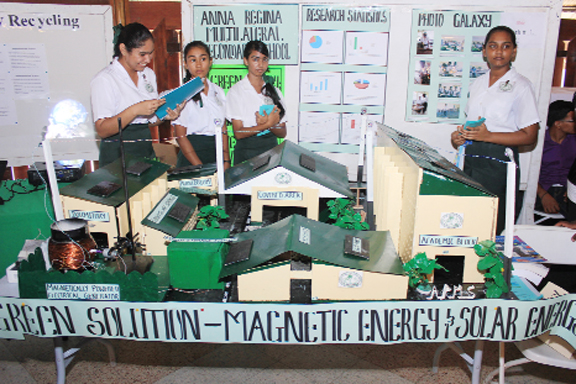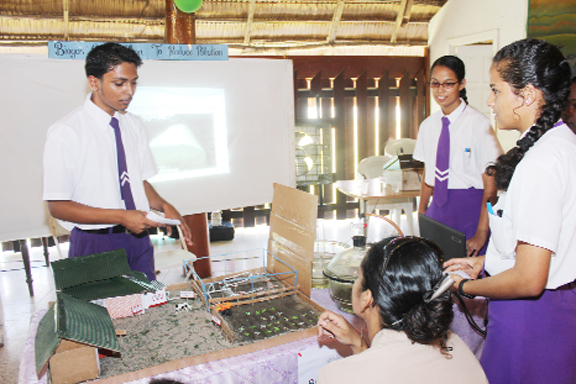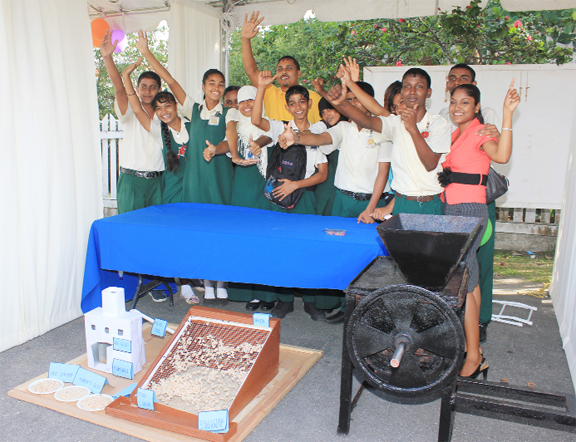West Coast Demerara school Zeeburg Secondary emerged the winner of the Sagicor Visionaries Challenge Guyana final at the Umana Yana yesterday with its innovative shrimp dryer, which would serve to reduce air pollution at that school.
Twenty schools from across the country yesterday presented 32 projects in the competition aimed at creating passion and excitement around Science, Technology, Engineering and Mathematics (STEM). The Caribbean Science Fund (CSF), Sagicor and Caribbean Examination Council worked with Ministries of Education to create the Sagicor Visionaries Challenge which was launched in high schools across the region.
Students were encouraged to identify a challenge facing their school or a school of their choice and using STEM, develop effective, innovative and sustainable solutions.
The Guyana final was an exhibition of innovative, effective and sustainable solutions ranging from, ‘Eradication of mosquitoes using Bacillus Thuringiensis’ to ‘Biogas generation from farm and kitchen waste: a clean source of fuel and electricity’.
A panel of 12 judges was selected to evaluate the students to see how relevant their projects were to their respective communities, creativity, innovativeness, project plan and the link to STEM.
Zeeburg Secondary emerged as the winner at the Guyana national level, with its project ‘Use of a shrimp dryer to reduce air pollution at Zeeburg Secondary’; President’s College copped the first runner-up position with ‘Biogas generation from farm and kitchen waste: a clean source of fuel and electricity’ and Skeldon Line Path was second runner-up.

The winning entry saw students using STEM to implement the use of a shrimp dryer to reduce air pollution at the Zeeburg Secondary School. Students at the school related to Stabroek News that the school is located next to a seawall where a lot of shrimp drying is done. As a result they are faced with a pollution problem. They proposed the construction of a shrimp processor to reduce the adverse environmental effects experienced by the school.
Lakshman Ramdat group leader for the winning school stated that the waste product obtained from shrimp drying cannot be recycled but with the use of technology they can process this waste product to make feed for animals and calcium fertilisers.
He further stated that the use of a shrimp processer will result in a reduction in air pollution as well as manpower and time taken to process the shrimp, as against the traditional method used.
Dhanraj Rambarose, teacher at Zeeburg said that they were elated at the win because the students sacrificed a lot to get the project done.
Prizes for the best presentation were awarded to Zeeburg Secondary, President’s College and Anna Regina Secondary. The best use of STEM awards went to President’s College, Skeldon Secondary, Zeeburg Secondary and Tagore Memorial.
The best plan and project design award went to President’s College. The most creative and innovative award went to the Zeeburg Secondary School.
The award for most relevant and sustaining project to the Caribbean Community went to St Ignatius Secondary for its ‘Self-sustainable water supply’.
Group Chief Operating Officer at Sagicor Richard Kellman stated that this is the first year of the initiative and Guyana has submitted the highest number of projects. Judging from the exhibits, he continued, Guyana has set a very high standard for the other countries. He appealed to the business community to work with students to ensure that the projects are implemented.

Olato Sam, Chief Education Officer applauded Sagicor for the initiative, calling it a landmark occasion for education in Guyana. He added that the ministry was elated to be part of it and was looking forward to the spin off effects of this exercise.
The participating schools were: Anna Regina Multilateral, Richard Ishmael Secondary, Saraswati Vidya Niketan, the Bishop’s High, Tutorial High, Queen’s College, Central High, President’s College, Tagore Memorial Secondary, St Rose’s High, Zeeburg Secondary, Annandale Secondary, Covent Garden Secondary, Corentyne Comprehensive, Mackenzie High, Skeldon Line Path, West Demerara Secondary, St Ignatius Secondary, Diamond Secondary and St Stanislaus College.
Students were required to submit an essay of 250 words describing their STEM-based project and how they could propose a solution to the problem in their community.
The team leader and supervising teacher will represent the school at the regional level, which will be held in Barbados in April. Prizes at the regional competition will include US$5,000 for the winner, US$3,000 for the first runner-up and US$1,000 for the second runner-up.
There will also be a Sagicor Visionaries STEM Ambassador Programme where winning students/teams along with their teachers will be invited to participate in an all-expenses-paid programme in Florida during summer 2013.

Through this programme they will participate in diverse inquiry based STEM learning experiences at places like the Kennedy Space Center and existing STEM/sustainability initiatives lead by Caribbean Diaspora faculty at one of Florida’s institutions of higher learning.
Certificates of appreciation were presented to each of the participating schools.





